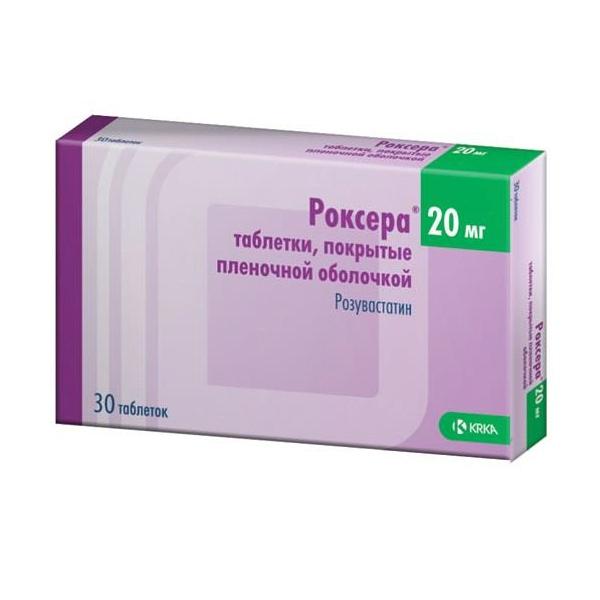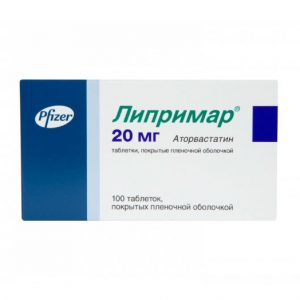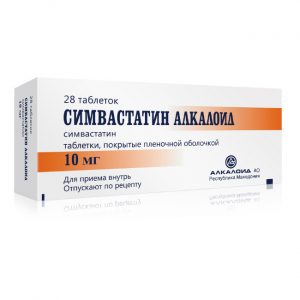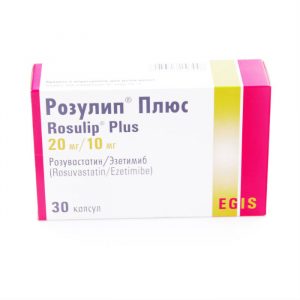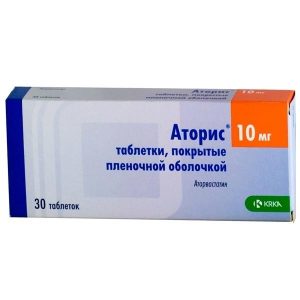Description
release form
film-coated tablets
Packing
30 pcs
Pharmacological action
Roxer drug – lipid-lowering agent. The active substance of the drug – rosuvastatin – is selective, a competitive inhibitor of HMG-CoA reductase, an enzyme that converts 3-hydroxy-3-methylglutaryl coenzyme A to mevalonic acid, the precursor of cholesterol. The main target of the action of rosuvastatin is the liver, where the synthesis of cholesterol (cholesterol) and LDL catabolism occur. It increases the number of hepatic LDL receptors on the cell surface, increasing the uptake and catabolism of LDL, which in turn leads to inhibition of the synthesis of VLDL, thereby reducing the total amount of LDL and VLDL. Rosuvastatin reduces elevated plasma concentrations of LDL cholesterol (LDL-C), total cholesterol, triglycerides (TG), and increases the concentration of high density lipoprotein cholesterol (HDL-C). It also reduces the concentration of apolipoprotein B (ApoB), cholesterol-free cholesterol, cholesterol-VLDL, TG-VLDL and increases the concentration of apolipoprotein AI (Apo A-1) in blood plasma.
Rosuvastatin reduces the ratio of cholesterol-LDL / cholesterol-HDL, total cholesterol / cholesterol-HDL and cholesterol-non-HDLP / cholesterol-HDL and the ratio of ApoV / ApoA-1. The therapeutic effect develops within one week after the start of therapy, after 2 weeks of treatment reaches 90% of the maximum possible effect. The maximum therapeutic effect is usually achieved by the 4th week of therapy and is maintained with continued regular use of the drug.
Indications
primary Fredrickson hypercholesterolemia (type IIa) or mixed dyslipidemia (type IIb) as a supplement to the diet for the ineffectiveness of the diet and other non-drug therapies (e.g. physical exertion, weight loss)
familial homozygous hypercholesterolemia as an adjunct to diet and other lipid lowering therapy (e.g. LDL apheresis) or if such therapy is not effective
hypertriglyceridemia (Fredrickson type IV) as an adjunct to the
diet to slow the progression of atherosclerosis in patients who are shown therapy to reduce the plasma concentration of cholesterol and cholesterol-LDL
primary prevention of major cardiovascular complications (stroke, myocardial infarction, arterial revas ulyarizatsiya) in adult patients without clinical evidence of coronary heart disease (CHD), but with an increased risk of its development (age over 50 years for men and over 60 for women, increased plasma concentration of C-reactive protein ( 2 g / l) in the presence of at least one of the additional risk factors, such as arterial hypertension, low plasma concentration of HDL-C, smoking, early onset of coronary heart disease in a family history.
Contraindications
Daily dose up to 30 mg
hypersensitivity to rosuvastatin or any of the components of the drug
liver disease in the active phase (including a persistent increase in the activity of hepatic transaminases and an increase in the activity of hepatic transaminases in blood serum by more than 3 times compared with B)
severe renal failure (creatinine Cl less than 30 ml / min)
myopathy
concomitant use of cyclosporine
patients predisposed to the development of myotoxic complications
take Nost, breastfeeding
use in women of childbearing age who are not using adequate contraception methods
lactose intolerance, lactase deficiency, glucose-galactose malabsorption syndrome
age of 18 years.
Daily dose of 30 mg or more
hypersensitivity to rosuvastatin or any of the components of the drug
liver disease in the active phase (including a steady increase in the activity of hepatic transaminases and an increase in the activity of hepatic transaminases in blood serum by more than 3 times compared with VGN)
renal moderate to severe insufficiency (Cl creatinine less than 60 ml / min)
myopathy
simultaneous use of cyclosporine
patients predisposed to the development of myotoxic complications
pregnant st, breastfeeding
use in women of childbearing age who do not use adequate contraceptive methods
hypothyroidism
muscle disease in history (including in family)
myotoxicity with other inhibitors of HMG-CoA reductase or fibrates with a history of
excessive alcohol consumption
conditions that can lead to an increase in the concentration of rosuvastatin in blood plasma
simultaneous use of fibrites
lactose intolerance lactose intolerance malabsorption
patients of the Mongoloid race
age to 18 years.
Precautions
Daily dose up to 30 mg
Presence of a risk of myopathy / rhabdomyolysis – renal failure, hypothyroidism, a history of inherited muscle diseases (including family history) and a previous history of muscle toxicity with other HMG-CoA reductase inhibitors or fibrates excessive alcohol consumption age over 65 years of age condition, in which there is an increase in the plasma concentration of rosuvastatin, race (Mongoloid race – Japanese and Chinese), simultaneous use of liver disease with a history of sepsis, arterial hypotension, extensive surgery, trauma, severe metabolic, endocrine or electrolyte disturbances or uncontrolled seizures, simultaneous use with ez.
Daily dose of 30 mg or more
Renal failure of mild severity (Cl creatinine over 60 ml / min) age over 65 years of liver disease with a history of sepsis arterial hypotension extensive surgery, trauma, severe metabolic, endocrine or electrolyte disturbances or uncontrolled seizures, simultaneous use with ezetimibe.
Use during pregnancy and lactation
Roxer is contraindicated in pregnancy and lactation.
Women of reproductive age should use adequate methods of contraception.
Since cholesterol and substances synthesized from cholesterol are important for the development of the fetus, the potential risk of inhibition of HMG-CoA reductase in the fetus outweighs the benefits of the drug during pregnancy.
In case of pregnancy during treatment, the drug should be stopped immediately.
There are no data on the excretion of rosuvastatin with breast milk (it is known that other HMG-CoA reductase inhibitors are excreted in breast milk), therefore, during breastfeeding, the use of the drug must be discontinued.
Composition
1 tablet contains:
Active ingredient: rosuvastatin 20 mg
Excipients: MCC lactose crospovidone silicon dioxide colloidal magnesium stearate.
Dosage and administration
Inside, do not chew or grind the tablet, swallow whole, washed down with water, can be taken at any time of the day, regardless of food intake.
Before starting therapy with Roxer, the patient should start to follow a standard hypocholesterolemic diet and continue to follow it during treatment. The dose of the drug should be selected individually, depending on the goals of therapy and the therapeutic response to treatment, taking into account recommendations on target plasma lipid concentrations.
Recommended starting dose for patients beginners to take the drug, or for patients transferred from taking other HMG-CoA reductase inhibitors, should be 5 or 10 mg of Roxer drug 1 time per day.
With the simultaneous use of the drug with gemfibrozil, fibrates, nicotinic acid in a dose of more than 1 g / day, patients are recommended an initial dose of 5 mg. When choosing an initial dose, one should be guided by the individual plasma cholesterol concentration and take into account the possible risk of developing cardiovascular complications, it is also necessary to take into account the potential risk of side effects. If necessary, the dose can be increased after 4 weeks.
Due to the possible development of side effects when applying a dose of 40 mg / day, compared with lower doses of the drug, increasing the dose to 40 mg / day after additional use of the dose above the recommended initial dose for 4 weeks of therapy can be carried out only in patients with severe hypercholesterolemia and a high risk of developing cardiovascular complications (especially in patients with familial hypercholesterolemia) the desired result of therapy was achieved with a dose of 20 mg / day and which will be under the supervision of a doctor. Particularly careful monitoring of patients receiving the drug at a dose of 40 mg / day is recommended.
The use of a dose of 40 mg / day in patients who have not previously consulted a doctor is not recommended. After 2-4 weeks of therapy and / or with an increase in the dose of the Roxer drug, monitoring of lipid metabolism is necessary (dose adjustment is necessary if necessary).
Patients with renal failure. In patients with mild or moderate renal failure, dose adjustment is not required. In patients with severe renal failure (Cl creatinine less than 30 ml / min), the use of Roxer is contraindicated. The use of the drug in a dose of more than 30 mg / day is contraindicated in patients with moderate to severe renal failure (Cl creatinine less than 60 ml / min). For patients with moderate renal failure, the recommended initial dose of the drug is 5 mg / day.
Patients with liver failure. Roxer is contraindicated in patients with active liver disease. There is no experience with the use of the drug in patients with liver failure above 9 points (grade C) on the Child-Pugh scale.
Use in elderly patients. Patients over the age of 65 are recommended to start using the drug with a dose of 5 mg / day.
Special populations of
When studying the pharmacokinetic parameters of rosuvastatin in patients belonging to different ethnic groups, an increase in systemic concentration of rosuvastatin was noted among Japanese and Chinese. This fact should be taken into account when using the Roxer drug in this group of patients. When applying doses of 10 and 20 mg / day, the recommended initial dose for patients of the Mongoloid race is 5 mg / day. Patients of the Mongoloid race, the use of the drug in a dose of 40 mg is contraindicated.
Patients predisposed to myotoxic complications. The use of the drug in a dose of 40 mg in patients predisposed to the development of myotoxic complications is contraindicated. If it is necessary to use doses of 10 and 20 mg / day, the recommended initial dose for this group of patients is 5 mg. When used with gemfibrozil, the dose of Roxer should not exceed 10 mg / day.
Side effects
Classification of the incidence of side effects: very often -> 1/10 often -> 1/100, but 1/1000, but 1/10000, but
The incidence of side effects depends on the dose taken.
On the part of the immune system: rarely – hypersensitivity reactions, including angioedema.
From the side of the central nervous system: often – headache, dizziness very rarely – polyneuropathy, memory loss.
From the digestive system: often – constipation, nausea, abdominal pain rarely – pancreatitis, increased activity of hepatic transaminases very rarely – jaundice, hepatitis, diarrhea.
From the skin: infrequently – itching, rash, urticaria, very rarely – Stevens-Johnson syndrome.
From the musculoskeletal system and connective tissue: often – myalgia rarely – myopathy (including myositis) and rhabdomyolysis very rarely – arthralgia.
A dose-dependent increase in creatine phosphokinase (CK) activity is observed in a small number of patients taking rosuvastatin. In most cases, it is mild, asymptomatic and temporary. In case of increased activity of CPK more than 5 times higher than VGN, therapy should be suspended.
From the urinary system: often – proteinuria (less than 1% of patients receiving a dose of 10 20 mg / day and about 3% of patients receiving a dose of 40 mg / day). In most cases, proteinuria decreases or disappears during therapy and does not mean the occurrence of acute or progressive concomitant kidney disease very rarely – hematuria.
Common violations: often – asthenia.
Laboratory indicators: increased CPK activity, glucose, bilirubin concentration, GGTP, alkaline phosphatase activity, change in plasma concentration of thyroid hormones.
Storage conditions
At a temperature not exceeding 30 ° C.
Expiration
2 years.
Active substance
rosuvastatin
Terms of dispatch from
pharmacies by prescription
lekarstvennaja form
tablets
KRKA d.d. Novo mesto AO, Slovenia
